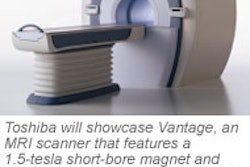Hitachi plans to use this year’s RSNA meeting to launch Airis Elite, the newest addition to the company’s line of MRI scanners. The scanner is a 0.3-tesla permanent-magnet unit designed to provide high-end imaging techniques in the mid-field MRI segment.

The scanner’s electronics have also undergone a makeover, with the migration to Airis Elite of the Scalable DualQuad RF system used on the higher-field Altaire scanner. The system provides four-channel support for a set of anatomically specific receiver coils, several of which are designed to support RAPID (rapid acquisition through a parallel imaging design), Hitachi’s parallel imaging technique. Hitachi has also included its Ascent software on Airis Elite.
For its superconducting 0.7-tesla vertical-field Altaire scanner, Hitachi plans to tout a recent performance enhancement that includes a new suite of pulse sequences and expanded RF system capabilities, provided to Hitachi customers at no charge. The vendor will also promote its Ascent 4.7 software upgrade, scheduled for release in early 2004.
Ascent 4.7 includes vascular imaging advances such as PEAKS (peak arterial enhancing k-space sequence), a k-space ordering technique, and a reduction in minimum TE and TR for improved image quality and throughput.
Hitachi is also introducing a peripheral vascular package for Altaire as an option. The package includes specially designed coil and runoff-control software with programmed table movement and timing control tools.
Hitachi has targeted breast imaging applications with a new multichannel bilateral breast coil that supports conventional diagnostic imaging as well as MRI-guided needle biopsy. Hitachi believes that Altaire’s open design improves patient access, making the scanner well-suited to breast imaging, and the system’s active shimming capability improves chemical fat suppression.
Hitachi will also show progress toward the addition of parallel imaging capabilities to Altaire with its RAPID feature. The company is designing head, body, and cardiac coils to support RAPID, which will be one of the features of a cardiac imaging package the company plans to introduce in 2004.
On the 0.3-tesla Airis II system, Hitachi will highlight its Ascent 4.5 software, which provides two new pulse sequences, balanced SARGE (BASG) and driven equilibrium fast-spin echo (DE-FSE). BASG is a steady-state gradient-echo sequence that provides high SNR and mixed T1 and T2 (bright fluid) weighting, according to the company.
DE-FSE provides the potential for shortened TR (over conventional T2 FSE) with enhanced T2 contrast. Hitachi also plans to migrate Altaire’s PEAKS feature to Airis II, in addition to new pulse sequences and user interface enhancements.



.fFmgij6Hin.png?auto=compress%2Cformat&fit=crop&h=100&q=70&w=100)




.fFmgij6Hin.png?auto=compress%2Cformat&fit=crop&h=167&q=70&w=250)











